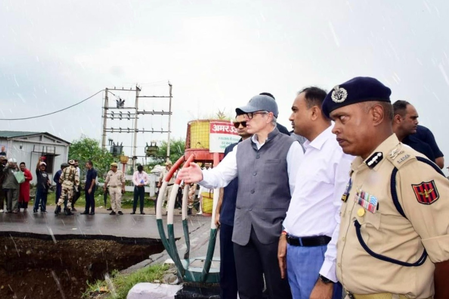J&K flood: Rivers in Jammu start receding, Jhelum crosses danger mark; CM briefs PM Modi
Jammu, Aug 27 (IANS) Water level in most rivers of Jammu division started receding gradually on Wednesday afternoon as mobile phones and Internet services were partially restored in Kashmir
Several pilgrims were feared dead and over two dozen others were injured on Tuesday when a landslide hit the route to Mata Vaishno Devi Shrine in Reasi district.
Union Home Minister Amit Shah, J&K Lt. Governor Manoj Sinha and Chief Minister Omar Abdullah have expressed grief at the tragedy and assured all possible help to the injured pilgrims.
CM Omar Abdullah said on X, “Spoke to Hon PM @narendramodi Sb a short while ago. I briefed him about the situation in J&K from the worst hit areas as I toured the parts of Jammu, along the banks of the Tawi, that saw a lot of damage yesterday. I’m grateful for his assurance of continued assistance to the people of J&K.”
L-G Sinha has directed the officials for the restoration of Power, Communication, and Water Supply on priority in areas where flood water is receding.
More than 5,000 people were evacuated from low-lying flooded areas to safety. The Army, NDRF and SDRF were working in coordination, helping in rescue and relief operations.
Divisional Commissioner Jammu, Ramesh Kumar, said, “We are ensuring that there is an adequate supply of relief materials and all possible assistance is being given to those affected.”
In a post on X, the L-G said: “Spoke to Divisional Commissioner, Jammu Sh. Ramesh Kumar and other Senior Officials and took stock of flood situation and rescue and relief Operations. Directed the officials for restoration of Power, Communication, Water Supply on priority in areas where flood water is receding.”
Jammu had recorded 380 mm of rainfall in 24 hours. This is the highest rainfall ever recorded in Jammu in 24 hours since 1910, when the weather observatory was established.
The last record was 270.4 mm registered on September 25, 1988. This has also broken the record of 218.4 mm recorded on August 23, 1996. This figure is close to 403.1 mm — Jammu’s monthly average for August.
Water level in Chenab, Tawi, Ravi, Basantar, Uhj and other rivers in Udhampur, Jammu, Kathua and Samba districts started receding gradually in the afternoon, while water level in the Jhelum River in the Valley crossed the flood alert level in Sangam in Anantnag district and Ram Munshibagh in Srinagar city.
While authorities closed all schools, colleges, universities, training institutes and government offices in Jammu, all schools, colleges and universities were closed in five districts of Srinagar, Pulwama, Shopian, Kulgam and Anantnag in the Valley.
Water from the overflowing Jhelum River entered Anantnag town as authorities kept the relief and rescue machinery in readiness.
Mobile Internet, calling and fibre services were restored at the G2 level by Jio and Airtel, while BSNL has asked its subscribers to switch to the G2 facility to avail these services in Jammu and Kashmir.
Train services between Jammu and Pathankot were restored after remaining suspended on Tuesday.
Srinagar-Jammu national highway, Srinagar-Leh, Sinthan Pass leading to Kishtwar district and Razdan Pass leading to Gurez from the Valley remained closed for the day.
In Jammu city, the 4th bridge on the Tawi River collapsed on Tuesday.
Two cloudbursts on Tuesday triggered flash floods in the Margi area of the Warwan Valley of Kishtwar, washing away at least 10 houses, over 300 kanals of crops, livestock, and a bridge.
The Meteorological (MeT) Department has forecast generally cloudy weather in J&K during the next 24 hours with intermittent spells of drizzle/ light rain/thunder.
People in Jammu and Kashmir divisions have been advised to stay away from rivers, streams and Nallahs as the flash flood threat still looms large over hilly areas.
–IANS
sq/dpb



Comments are closed.